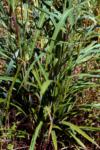Latin name
Rottboellia cochinchinensis (Lour.) W. Clayton
Family
Poaceae
Common name(s)
Itchgrass
Synonym(s)
Rottboellia exaltata L. f., Stegosa cochinchinensis Lour., Manisuris exaltata (L. f.) Kuntze, R. arundinacea Hochst. ex A. Rich.
Geographical distribution
South and Southeast Asia: India, Indonesia, Nepal, Philippines, and Thailand.
Rest of the world: Australia, Colombia, Ethiopia, Kenya, Madagascar, Nigeria, Puerto Rico, Sudan, Tanzania, United States, West Africa, and Zambia.
Morphology
An erect, branched, and coarse annual; up to 350—cm tall.
Stem: stout, branched, with prop roots and spongy inside.
Leaf: flat and hairy, linear lance-shaped, to about 45 cm long, with distinctive white midrib: sheaths armed with stiff irritating hairs.
Inflorescence: solitary cylindrical spike at terminal points of culm and branches, a "rat tail" raceme. Spike 8—15—cm—long, narrowed upward and breaks readily with 6—7—mm—long joints; spikelet paired, lower one is sunken in the cavity of a cylinder, about 4—mm—long rachis joint.
Biology and ecology
The plant is supported by stilt roots. It is common in open, well-drained places, dryland field crops, plantation crops, contour banks, roadsides, and vegetables.
Propagates by seed, may flower year-round in tropics. A serious weed in maize.
Agricultural importance
Grows rapidly and is a very competitive weed. Seeds are similar in size to rice grains and can be hard to separate. An alternate host of rice leaf gall virus and corn leaf gall virus; also harbors nematodes and the insect Euscyrtus concinnus (de Haan).
Management
Cultural control: regular cultivation of fields; will not tolerate flooded conditions.
Biological control: a head smut, Sporisorium (Sphacelotheca) ophiuri, which prevents seed formation, is a potential biological control agent.
Chemical control: preemergence application of pendimethalin or early postemergence treatment with cyhalofop, fenoxaprop, or propanil can be effective.
Selected references
Galinato MI, Moody K, Piggin CM. 1999. Upland rice weeds of South and Southeast Asia. Los Baños (Philippines): International Rice Research Institute. 156 p.Holm LG, Plucknett DL, Pancho JV, Herberger JP. 1997. The world's worst weeds. Honolulu, Hawaii (USA): The University Press of Hawaii. 609 p.Hsu C. 1978. Gramineae (Poaceae). Flora of Taiwan. 5:373-783.Merrill ED. 1976. A flora of Manila. Manila (Philippines): Department of the Interior, Bureau of Science. 491 p.Moody K, Munroe CE, Lubigan RT, Paller Jr. EC. 1984. Major weeds of the Philippines. Weed Science Society of the Philippines. Los Baños (Philippines): University of the Philippines. 328 p.Moody K. 1989. Weeds reported in rice in South and Southeast Asia. Manila (Philippines): International Rice Reseach Institute. 442 p.Pancho JV, Obien SR. 1995. Manual of ricefield weeds in the Philippines. Muñoz, Nueva Ecija (Philippines): Philippine Rice Research Institute. 543 p.
Contributors
JLA Catindig, RT Lubigan, and DE Johnson
